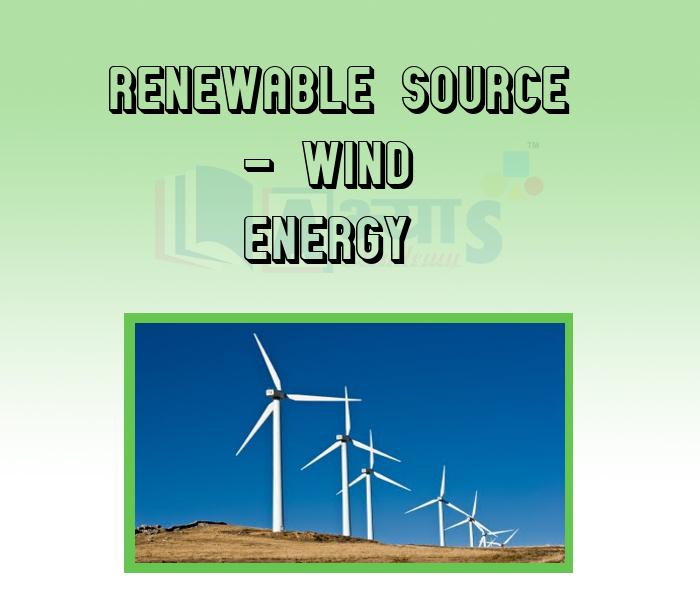Renewable Source - Wind Energy











Renewable Source - Wind Energy
Renewable Sources Of Energy: Those sources of encrgy, whlch are renewable in nature, are called renewable sources of energy. The renewable sources are generally pollution-free. Solar energy, hydel energy, wind energy, tidal energy, etc. are renewable sources of eergy. Those sources of energy whose formation takes millions of years and which are limited in supply are called non-renewable sources of energy, Non-renewable sources create heavy pollution. Coal, petroleum, natural gas, etc. are non-renewable sources of energy.
The advantage of such classilication of energy pources is that it helpa us to decide about the combervaubn of avnilable encrgy Bources for future generation. It also helps us in development of alternative soarces of cnergy accelerating the scope for the development of appropriate technology
Renewable Sources - Wind Energy: Sun's energy is the main factor responsible for the movement of air. Moving air is called wind and lt possesses kinctic energy. Windmills, invented 250 years ago by Persians, are once again gaining popularity. Modern windmills convert wind energy into either mechanical energy or electrical energy. A windmill consists of a fan-like structure mounted at some height on a strong support. Its blades are so designed that when wind strikes them, a pressure difference is created between them. This difference produces a turning effect and makes them rotate.
The height of the windmill, the number of blades and their shape, etc. are decided on the basis of average wind velocity and local environmental factors. The rotational motion of the windmill is utilised to obtain mechanical work like in a water-lifting pump. If a turbine is connected to the windmill, electricity can be generated but the electricity generated by one windmill cannot be used commercially. To generate a large amount of electricity, a wind energy farm is established where there are several windmills erected in a large area. In Gujarat, wind-energy farms are located at following places: Lamba near Porbandar, Okha, Mandavi and Dhank. The largest wind farm in India is near Kanyakumari in Tamil Nadu and it generates 300 MW of electricity. The greatest advantage of wind-energy farms is that the electricity is generated from a renewable source and it is pollution-free.
Limitations:
(i) Wind energy farms can be established only at places with continuous flow of wind.
(ii) The average wind velocity should be 16 km/h to enable its working.
(iii) It requires a large area of land and cost of installation is very high.
(iv) It creates noise pollution.
Students / Parents Reviews [10]
It was a good experience with Abhyas Academy. I even faced problems in starting but slowly and steadily overcomed. Especially reasoning classes helped me a lot.

Cheshta
10thA marvelous experience with Abhyas. I am glad to share that my ward has achieved more than enough at the Ambala ABHYAS centre. Years have passed on and more and more he has gained. May the centre flourish and develop day by day by the grace of God.

Archit Segal
7thMy experience with Abhyas is very good. I have learnt many things here like vedic maths and reasoning also. Teachers here first take our doubts and then there are assignments to verify our weak points.

Shivam Rana
7thBeing a parent, I saw my daughter improvement in her studies by seeing a good result in all day to day compititive exam TMO, NSO, IEO etc and as well as studies. I have got a fruitful result from my daughter.

Prisha Gupta
8thAbhyas Methodology is very good. It is based on according to student and each child manages accordingly to its properly. Methodology has improved the abilities of students to shine them in future.

Manish Kumar
10thAbout Abhyas metholodology the teachers are very nice and hardworking toward students.The Centre Head Mrs Anu Sethi is also a brilliant teacher.Abhyas has taught me how to overcome problems and has always taken my doubts and suppoeted me.

Shreya Shrivastava
8thAbhyas is a complete education Institute. Here extreme care is taken by teacher with the help of regular exam. Extra classes also conducted by the institute, if the student is weak.

Om Umang
10thIt was good as the experience because as we had come here we had been improved in a such envirnment created here.Extra is taught which is beneficial for future.

Eshan Arora
8thMy experience was very good with Abhyas academy. I am studying here from 6th class and I am satisfied by its results in my life. I improved a lot here ahead of school syllabus.

Ayan Ghosh
8thMy experience with Abhyas academy is very good. I did not think that my every subject coming here will be so strong. The main thing is that the online tests had made me learn here more things.
